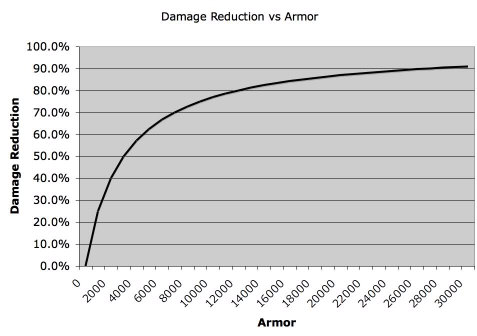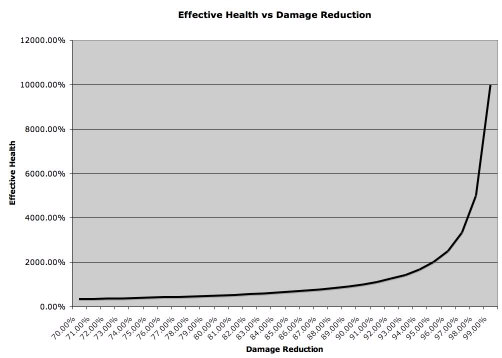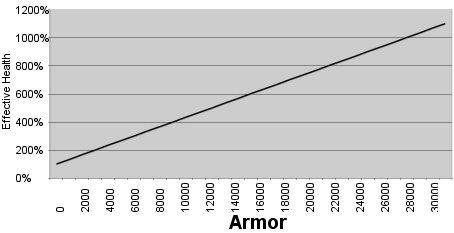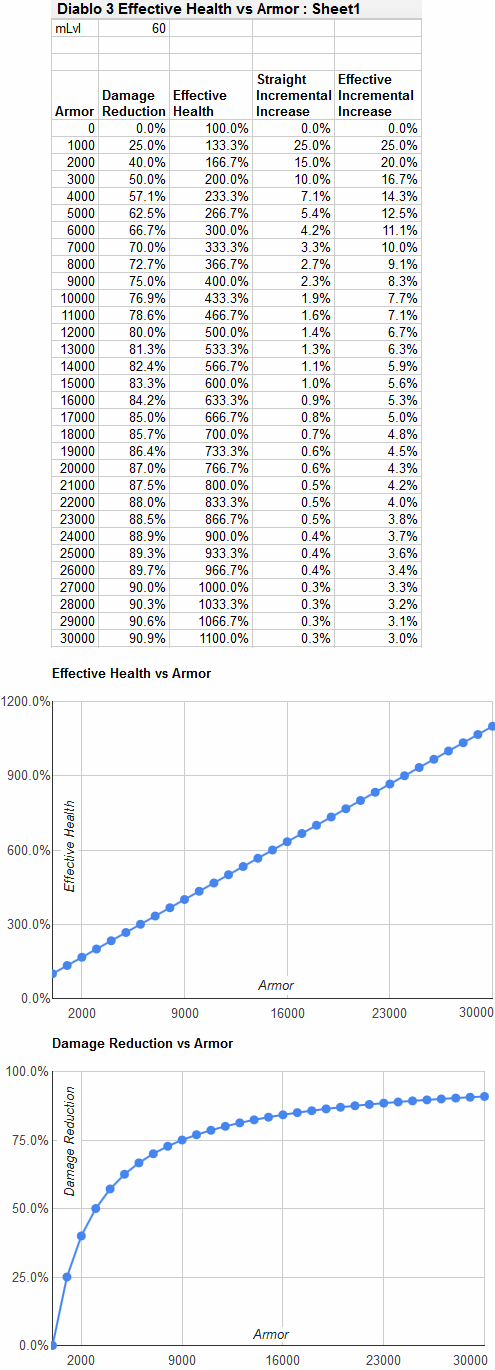This article discusses in depth how armor values effect
damage reductions in Diablo 3. I play a barbarian and I
think they can benefit from this information the most,
although other classes can benefit just the same. Just
to warn you, this article gets mathematically technical..
The graphs below aren't super exact because they
don't take into account things like: Buffs, passive
abilities, 30% DR for barbs (makes vit more powerful),
block, increased mLvl in inferno. So don't live your
life by them, but it's good for getting a better handle
on how armor, resistance, and vitality work together.
I have witnessed many people explaining
to others that armor has diminishing returns. While it
is true that the amount of damage reduction goes down as
armor goes up, the actual effect of armor on your
survivability remains constant.
NOTE: If you don't feel like reading
the technical math stuff, just jump down to the TLDNR
section where there is a graph showing effective health
vs armor.
Terms & Definitions:
Armor: Armor gives you % damage reduction against all
types of damage, not just physical. It is increased by
armor value on items, strength (1:1) and certain skills.
Diminishing Returns: The idea that an extra point
in something (Armor) yields less return than the points
before it. Ex. the 100 point in armor is less effective
than the 99th point.
Effective Health: Effective health
is the amount of damage it takes to kill you (not to be
confused with max health). If you have 1000 max health
and 25% damage reduction, you have an effective health
of 1333. You can determine your effective health by the
following formula: MaxHealth/(1-DamageReduction)
This is where a lot of people get confused. Having 50%
damage reduction does not allow you to take 50% more
damage, it's a lot more than that. Consider this
scenario: You have 1000 max health and 50% damage
reduction. A monster is hitting you for 100 unmitigated
damage, which only does 50 damage to you because you
have 50% DR. It will take that monster 20 hits to kill
you (1000 HP / 50 dmg) which means you can actually take
2,000 unmitigated damage (20 hits * 100 dmg). So with
50% DR you have 200% effective health, not 150.
mLvl:
Stands for monster level. The level of the monster
you're fighting.
DR: Damage reduced (from armor).
Explanation:
DR from Armor = Armor / (Armor+(50*mLvl))
As you can see, there is a constant in the bottom (50*mLvl).
Armor is being divided by (Armor + 3000). It will always
approach but never reach 1 because Armor can never be
greater than or equal to (Armor + positive integer).
Graph illustrating damage reduced as armor increases:

The graph shows that as armor increases, additional
points in armor yield less and less DR. Most people call
this diminishing returns and explain that the more armor
you have the less additional armor is worth. That is
wrong. The reason it is wrong is because the effect of
each additional point of DR is more powerful than the
last. So in order to keep the effectiveness of armor
linear, each point must must yield less damage reduction
because each point of damage reduction is more effective
than the last.
Graph illustrating your effective health as DR
increases:

To further illustrate my last point lets look at an
example:
-At 70% DR you have an effective health of 333.3%,
increase over last = 10.8%
-At 71% DR you have an
effective health of 344.8%, increase over last = 11.5%
-At
72% DR you have an effective health of 357.1%, increase
over last = 12.3%
...
-At 95% DR you have an effective health of 2000%,
increase over last = 333.35%
-At 96% DR you have an
effective health of 2500%, increase over last = 500%
If every point in armor gave you the same amount of DR,
each point of armor would be more effective than the
least. Meaning that the best way to play the game would
be to stack as much armor as possible. This is why
Blizzard has balanced armor so that its relationship
with effective health is linear. Most of you who have
played WoW are probably familiar with this concept
because they do it with almost all damage reduction
stats. As a little side note, you may remember that
resilience in WoW was slightly unbalanced so that each
additional point in resilience was better than the last
(but not by much).
Without further ado, here is the most important graph in
the series. This graph shows your effective health as
armor increases:

People should also note that the same thing holds true
for resistances (and resistances via int). The formulas
are basically the same.
DR from resistance = Resistance / (Resistance + (5 * mLvl))
Resistance from int = int * 0.1
Which boils down to, DR from int = int / (int + (50 *
mLvL))
Which is the same formula as armor. So yes for int also
the effect on survivability is linear.
TLDNR
Every 1000 points of Armor increases your effective
health by 1/3 of your max health (with no other DR
sources), regardless of how many points you do or do not
have in Armor already. The same goes for resistances.
Here is a graph showing
effective health and DR as armor increases:

How this effects actual game play:
We all have the same question: Which is better for me?
It depends on your current stats! (surprise, right?).
For example, I play a barb with about 42k HP and 7000
armor. Currently 1 point of vitality is worth a little
more than 8 points in armor.
-If Item One has 10 extra vitality and Item Two has 70
extra armor, I will go with Item One.
-If Item One has 10
extra vitality and Item Two has 90 extra armor, I will
go with Item Two.
The same probably doesn't hold true for you. So I made
it easy. Here is a dashboard you can use to input your
current stats and have it tell you how good vitality is
vs armor for you. You can also select "Compare Items"
and compare up to 5 items to each other based on their
Vitality and Armor stats:
//www.swfcabin.com/open/1337704597
If there's any real use out of the thing I can
incorporate +%life and resistances and stuff. But for
now it just tells you Armor vs Vitality.
END TLDNR
Final Note on Resistance/Armor:
There's a bit more to
the whole thing that just that.
First, 1 resistance is basically always better than 1
armor, obviously. And 1 int is worth 0.1 resistance, so
10int > 1 armor.
Second, how good resistance/int is
versus armor depends on your current armor and
resistance. So don't necessarily stack one to the
detriment of the other.
-The more Armor you have the better resistance
becomes.
-The more resistance you have the better Armor
becomes, relative to each other.
Now comes the question: which is better for me
specifically? Well, it should be possible to tell how
much armor is worth 1 resistance point. I have put
together a matrix with Armor running across the top and
Resistance running down the side, find where your armor
and resistance intersect and it should tell you how many
points of armor equal 1 point of resistance.
Resistance vs
Armor Matrix
For me personally, my character's res/armor ratio is
about 20. So if I have to choose between 500 armor and
20 resistance, I will choose the armor.
And to the people who are like "omg what about int?"
Well, I don't know how you got this far without
realizing you can just take those values and divide them
by 10, but
here is a matrix showing the value of 1
additional point of int versus 1 additional point of
armor.
What about Revenge?
Note: If you're interested in how this affects life
leech builds, drop down to where it says LIFE LEECH.
Good question! I actually started looking
into armor because I was thinking about revenge and how
to get more use out of it. However, I quickly realized
that revenge doesn't matter, and in fact no healing
abilities do. Here's why:
Revenge heals you for 5% of your max hp. If you have
more max hp, then you will be healed for more. Sounds
like more vitality = better revenge, right? Wrong. If
stack vitality, then revenge will give you a bigger
heal. However, if you stack armor revenge will give you
a smaller heal but those health points are effectively
worth more because of your armor value. Either way
though, it will heal you for exactly 5% of your max
health which is also the same thing as healing you for
5% of your effective health. But anyways let me show you
an example.
This might get hairy but follow along. Sorry I'm not the
best at explaining things.
Lets say you have 10k HP and 1000 armor (25% DR).
Revenge heals you for 500 (10,000 * 0.05). Which is
worth 666.6 effective health (500 / (1-0.25) ). If we
increase your vitality by 100, your health becomes
13,500 (10,000 = (100*35) ). Now revenge heals you for
675 hp (13,500 * 0.05), which is worth 900 effective
health (675 / (1-0.25) ) when you have 1000 armor (25%
DR). At those health and armor levels you can see that 1
point of vitality is worth about 14.1 points of armor.
Now instead of increasing your vitality, we increase
your armor by 1410 points (14.1 points for each
increased point of vitality in the previous example). So
you have 10k HP and 2410 Armor (44.6% DR). A revenge
still heals you for 500 like in the beginning (10,000 *
0.05), but those 500 health points are worth 900
effective health points (500 / (1 - 0.446) ).
Here is a little worksheet showing that example.
So from this you can see that revenge heals you for 5%
of your health, which gives you back 5% of your
effective health. So actually all the ratio stuff
between armor and vitality is completely unaffected by
revenge and you should pay it no mind.
LIFE LEECH
Now what actually IS INTERESTING is the affect of other
types of heals on the barb and how armor and vitality
impact them, or rather don't. Any kind of heal that
isn't based on a % of your max HP gets BETTER with more
armor and is completely UNAFFECTED by vitality. This is
because while it is healing the same amount, those
health points are worth more when you have more armor.
Lets look at the passive skill bloodthirst. It is a
barbarian passive that heals you for 3% of the damage
you deal. Here is a spreadsheet showing the same example
as above, but
looking at the effective healing of 1
strike with bloodthirst active.
The moral of the story is this: If you want to try some
kind of leeching build using bloodthirst and +life on
hit mods, you should definitely stack armor and
resistances over vitality to make your heals more
effective. Also, I admit I don't have much knowledge of
other classes but I assume they have some heals that are
static or based on damage dealt. So anyone of any class
trying to make a leech build should focus on res/armor
over vitality.
For a lot of interesting strategies and stuff for Diablo
3 I recommend getting
Diablo 3 Gold Secrets By Peng Joon, there is a small price for it but
worth it.

